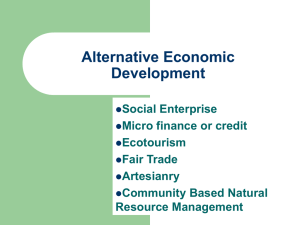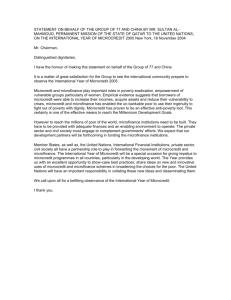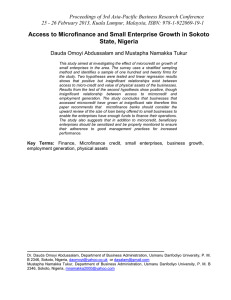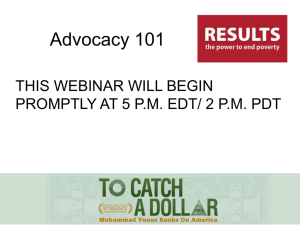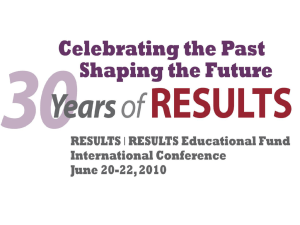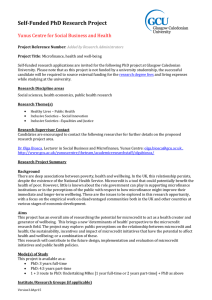Rita Hamad Bixby Fellowship: Final Report
advertisement
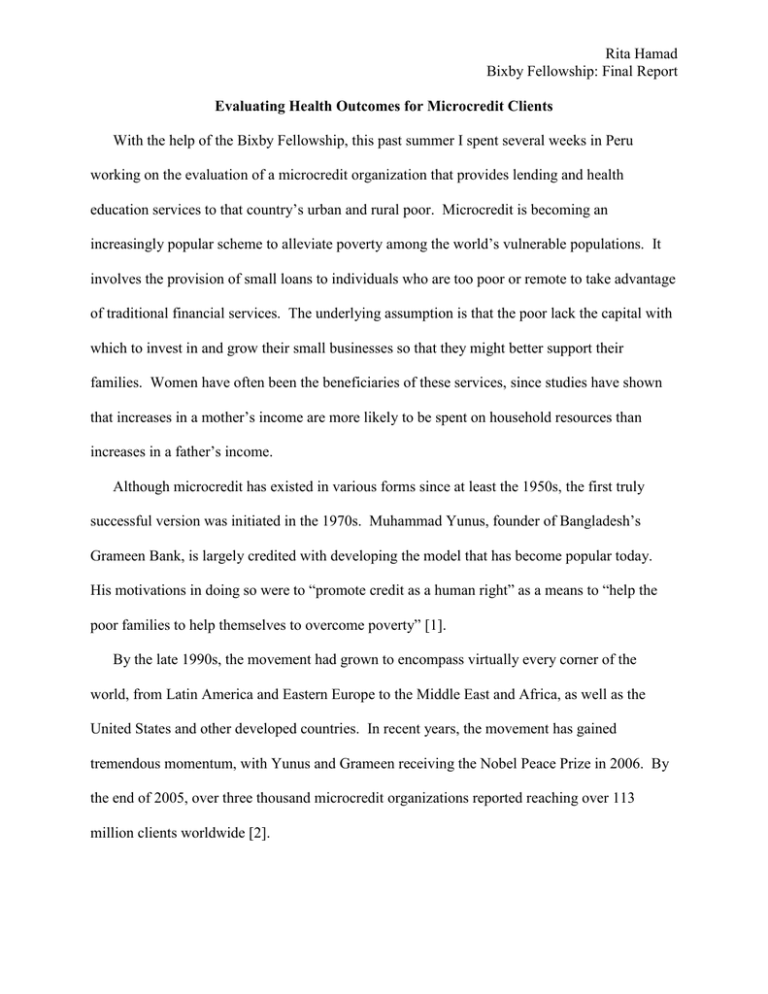
Rita Hamad Bixby Fellowship: Final Report Evaluating Health Outcomes for Microcredit Clients With the help of the Bixby Fellowship, this past summer I spent several weeks in Peru working on the evaluation of a microcredit organization that provides lending and health education services to that country’s urban and rural poor. Microcredit is becoming an increasingly popular scheme to alleviate poverty among the world’s vulnerable populations. It involves the provision of small loans to individuals who are too poor or remote to take advantage of traditional financial services. The underlying assumption is that the poor lack the capital with which to invest in and grow their small businesses so that they might better support their families. Women have often been the beneficiaries of these services, since studies have shown that increases in a mother’s income are more likely to be spent on household resources than increases in a father’s income. Although microcredit has existed in various forms since at least the 1950s, the first truly successful version was initiated in the 1970s. Muhammad Yunus, founder of Bangladesh’s Grameen Bank, is largely credited with developing the model that has become popular today. His motivations in doing so were to “promote credit as a human right” as a means to “help the poor families to help themselves to overcome poverty” [1]. By the late 1990s, the movement had grown to encompass virtually every corner of the world, from Latin America and Eastern Europe to the Middle East and Africa, as well as the United States and other developed countries. In recent years, the movement has gained tremendous momentum, with Yunus and Grameen receiving the Nobel Peace Prize in 2006. By the end of 2005, over three thousand microcredit organizations reported reaching over 113 million clients worldwide [2]. Rita Hamad Bixby Fellowship: Final Report Yet evidence regarding the outcomes of microcredit on the poor families whom it targets remains contested. While some studies report that microcredit has a positive economic impact on the communities where it is implemented, others document mixed or even negative outcomes in certain circumstances [3]. Moreover, many studies are carried out by the microcredit organizations themselves, putting their objectivity into question, and virtually all suffer from design flaws that undermine their scientific value. Furthermore, data still conflict regarding microcredit’s effect on women’s empowerment and other sociopolitical outcomes. For example, some studies have documented instances in which women have been forced by their husbands to take out loans for their families [4]. Others suggest that women participating in lending programs often suffer from a “dual burden” of both housework and their business outside of the home [5], potentially adversely affecting their health and that of their children. One study showed increased contraceptive use on the one hand, and yet found that the number of children among microcredit clients was no different than controls [6]. More generally, initial studies are still inconclusive regarding whether microcredit programs are improving the health and wellbeing of the communities in which they are conducted. Studies have repeatedly shown that income is one of the factors strongly associated with physical and mental wellbeing [7, 8] since it may be used to purchase food or healthcare. At the same time, economic growth alone doesn’t necessarily lead to healthier families, especially if basic health knowledge or health services are absent or lacking [9]. Few studies, however, have attempted to directly examine the connection between microcredit and health. Thus, while billions of dollars are currently poured into microcredit programs annually with the assumption that they will result in poverty alleviation and improvement of health outcomes, Rita Hamad Bixby Fellowship: Final Report there is little evidence to demonstrate that this actually takes place, and if so, what contextual circumstances or client characteristics make positive outcomes more likely. This study attempts to answer this question. It addresses many of the shortcomings in the existing evidence by analyzing data collected among clients of Proyectos de Informática, Salud, Medicina, Agricultura (PRISMA), a non-governmental organization (NGO) based in Lima, Peru that provides microcredit and other services to poor men and women throughout the country. Using a more rigorous design than previous studies in this field, this evaluation assesses the effects of microcredit and health education services administered to clients in Pucallpa, a city in the Amazon region of Peru. Baseline data were collected from study participants in February 2007. Clients were asked about their reproductive, mental, and general health, as well as contextual factors such as demographic information and household characteristics. Anthropometric data were also obtained. The intervention was then randomized, and this summer I traveled to Peru to plan for the follow-up survey that will be occurring later this year. This included designing the questionnaire and training the surveyors who will be interviewing the 1,800 clients. The project staff have decided to conduct only one follow-up survey at the one-year mark instead of two six-month surveys, due to logistical and financial reasons. On the other hand, we have also decided to include a qualitative component to be conducted this fall in an attempt to capture the attitudes of clients and PRISMA staff regarding the progress of the intervention. This summer I laid the groundwork for these activities by training surveyors and refining the methodology. During this trip I was also able to visit the outlying parts of the city in order to sit in on the microcredit and health education sessions that we are evaluating. I had informal conversations with women who consider the small loans to be a blessing and a path towards empowerment, and Rita Hamad Bixby Fellowship: Final Report others who divulged to me their difficulties in making payments and their frustration with the process. I was honored to be able to enter the homes of some of PRISMA’s clients, and I was humbled by the conditions in which they live. While I hope that the intervention is improving their lives, these visits make it clear that there are much broader infrastructural and political changes that need to take place so that even the most basic needs – such as roads, water, and electricity – are met. This time in the field has been crucial to my synthesis and understanding of the issues at hand, and it has spurred additional research questions that will hopefully be answered by data from this and future studies. While it will be several months before the follow-up data are available for analysis, I am excited about the potential for this project to demonstrate some of the strengths and pitfalls of microcredit in affecting the health of the women whose livelihoods are at stake. With this information, PRISMA will hopefully be able to refine its services to meet its clients’ needs in Peru, and other microcredit institutions may also be able to design and implement their interventions more effectively to create positive impacts among the poor whom they serve. References 1. Yunus M. What is microcredit? 2005. 2. Daley-Harris S. State of the Microcredit Summit Campaign Report. Washington, DC, 2006. 3. Mosley P, Hulme D. Microenterprise finance: is there a conflict between growth and poverty alleviation? World Development 1998;26:783-790. 4. Rahman A. Micro-credit initiatives for equitable and sustainable development: who pays? World Development 1999;27:67-82. 5. Brett J. “We sacrifice and eat less”: the structural complexities of microfinance participation. Human Organization 2006;65:8-19. 6. Goldberg N. Measuring the impact of microfinance: taking stock of what we know. Washington, DC: Grameen Foundation USA, 2005. 7. Lynch JW, Kaplan GA, Salonen JT. Why do poor people behave poorly? Variation in adult health behaviours and psychosocial characteristics by stages of the socioeconomic lifecourse. Social Science and Medicine 1997;44:809-819. 8. Smith Fawzi MC, Lambert W, Singler JM, et al. Factors associated with forced sex among women accessing health services in rural Haiti: implications for the prevention of HIV Rita Hamad Bixby Fellowship: Final Report infection and other sexually transmitted diseases. Social Science and Medicine 2005;60:679-689. 9. Smith SC. Village banking and maternal and child health: evidence from Ecuador and Honduras. World Development 2002;30:707-723.
